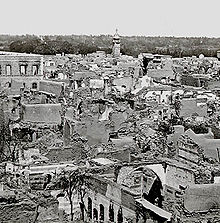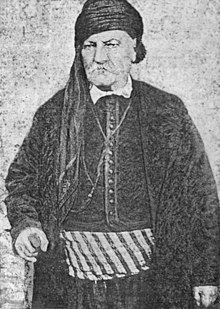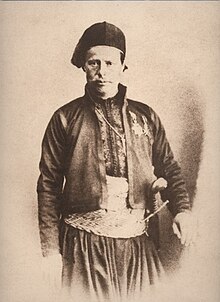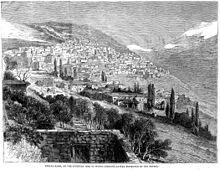Civil War in the Lebanon Mountains
The civil war in the Lebanon Mountains in 1860 , which is often referred to by other names, was the climax of a rural revolt of the Christian Maronites against the Druze , which emerged from Islam in the 11th century , more precisely against the landowners among them, which started in the Lebanon Mountains . It culminated in a massacre in Damascus . A total of 20,000 Christians were killed, plus an unknown number of Muslims. 380 Christian villages and 560 churches were destroyed. Finally, an international force under French leadership intervened. The civil war is considered to be the trigger for Lebanon's development towards later independence.
prehistory
Under Muhammad Ali , Egypt made itself practically independent and his son soon marched on the Ottoman capital Istanbul . In 1839 Great Britain, France, Russia, Austria and Prussia decided to drive the Egyptian army out of Anatolia , as an uncontrolled breakup of the Ottoman Empire could have unforeseeable consequences for them. The British fleet blocked the Syrian-Palestinian coast, Beirut was shelled, local uprisings broke out and the Ottoman army marched in. However, the Ottomans had to recognize Muhammad Ali as the hereditary viceroy in Egypt in 1841.
On September 3, 1840, Bashir Shihab III. , Successor of the influential emir Bashir Schihab II. (1789–1840), elevated to the rank of emir of the Lebanon Mountains by the sultan. During the Egyptian reign of Ibrahim Pascha , the son of Muhammad Ali, in a Ferman from 1839, but then especially from 1856, non-Muslims were equated with Muslims. On the other hand, there was a backlash on the part of the Muslims, including the Druze, who felt deprived of their priority. Therefore, the Ottoman sultan deposed the emir on January 13, 1842 and named Omar Pasha as governor, but he was soon replaced.
The representatives of the Western European states suggested to the sultan to divide the area into a Druze and a Maronite district, a proposal that he accepted on December 7, 1842. He asked the governor in Damascus to divide the area into a northern, Maronite, and a southern, Druze district. Your dividing line should be the Beirut-Damascus road. In addition, both should now be accountable to the governor in Eyâlet Sidon, who resided in Beirut .
Course of war
In May 1845 the first conflicts arose, after which the Sultan set up councils to represent the religious groups that appeared to be behind the conflicts. The social component soon disappeared from the outside world, so that it appeared as an exclusively religious conflict.
When the farmers of the Keserwan district , who felt that they were overwhelmed by taxes, rebelled, they turned against the feudal structures in particular. In 1858 Tanyus Shahin , one of the Maronite leaders, called for the abolition of feudal prerogatives. When this demand was rejected, an armed uprising began under him in January 1859. It was initially directed against the Maronite Chazen muqata'dschis (feudal lords) of Keserwan, whose lands they occupied and formed their own government. The unrest spread to Latakia and central Lebanon. Maronite country people were now preparing for a general revolt against their Druze masters. These in turn began to arm Druze groups.
In August 1859 disputes arose in the Metn region of the Christian sector of Qaimaqamate, which prompted the Maronite Bishop Tubiya Aun († April 4, 1871) to intervene from Beirut. A Druze muqata'ji from the Yazbaki faction, Yusuf Abd al-Malik, intervened armed in a village called Beit Mery , where 20 people were killed. While the Druze were preparing for war in league with the Ottoman authorities, Bishop Aun had weapons distributed.
Between March and May 1860 there were murders, looting and fighting. According to historian Leila Tarazi Fawaz, these attacks were "random and unpredictable enough that they were attributed to outlaws rather than being perceived as part of a calculated war against other sects, especially since banditry was always part of the process." In March, a Catholic monk in Aammiq was killed and the monastery ransacked, starting a cycle of reciprocal acts of revenge. In April two Druze were killed near Beirut, whereupon three Christians lost their lives near Sidon, followed by the deaths of two Christians from Jezzine in Chan Iqlim al-Shumar on April 26th. On April 27, two other Christians were murdered in Katuli; for which on May 11th two Druze at Nahr al-Assal and on May 14th two Druze from Chouf near Sidon were murdered. This chain of acts of revenge not only made the streets unsafe, but the conflict escalated , so that complaints at the western consulates increased in May that Christians had now also been murdered in the districts of Beqaa , Arqub and Gharb.
After Maronite raids in Metn and the advance of Shahin's people into the Gharb west of Beirut, the Druze held a council of war in Muchtara, where the moderate Jumblatti factions and the more warring Yazbaki on Sa'id Jumblatt as their leader.
The actual civil war began on May 27th, and occasionally also on May 29th. When a 250-strong Maronite militia from Keserwan, led by Taniyus Shahin, collected the silk harvest from Naccache , instead of returning, they marched on Baabda in the as-Sahil district near Beirut . The Druze viewed this as a provocation, while the Maronites saw themselves threatened by the stationing of Ottoman units under Churschid Pasha near Naqqash on May 26th. The Ottoman garrison settled in Hazmiyeh with the support of the western consuls to ensure peace.
On May 29, Keserwani Maronites attacked the mixed denominational villages of Qarnaye, Btechnay and Salima . The Druze were forced to leave the villages. When the Druze, in turn, the mixed village of Beit Mery, and the villagers called their fellow believers from Abadiyeh and as-Sahil for help, an open conflict broke out. Maronites burned the Druze houses in Beit Mery and defeated the Druze unit under Ibrahim Aga at the village before retreating. But they returned on May 30th, but were defeated by up to 2,000 Druze under the leadership of the Talhuq and Abu Nakad clans, which in turn drew neutral Maronites from Baabda, Wadi Shahrur, Hadath and other villages into battle . The next day the 200 Maronites at Beit Mery were beaten and forced to retreat to Brummana . Between 35 and 40 villages with a Maronite majority have now been set on fire and around 600 Maronites killed.
Already on May 30th, a fight between 200 Druze under Ali ibn Chattar Imad and 400 local Christians at Dahr al-Baidar had broken out at Zahlé . Now Christians from the nearby Zahlé got involved in the fighting, so that Imad withdrew to Ain Dara , under persecution by the Christians. Ali Imad died on June 3rd, whereupon a 600-strong Druze unit led by his father Chattar Imad soon fought a battle near Ain Dara, mainly from Zahlé. The Druze won, but they lost twice as many men as the opponents. Between May 29 and May 31, 60 villages around Beirut were destroyed, another 33 Christians and 48 Druze died.
At the end of May, Druze under Bashir Nakad besieged Deir al-Qamar with the support of the Imad and Jumblatt clans . An aid convoy with food led by the Ottoman general Churschid Pasha did not reach the besieged city. Bashir's forces, which now consisted of 3,000 Druze, attacked Deir al-Qamar on June 2nd and 3rd. 70 to 100 Druze were killed as well as 17 to 25 Christians. 130 houses were destroyed during the looting, which lasted until June 6th. About half of the Christian residents had remained neutral. They asked for the protection of the Druze, with which they connected personal and business contacts.
While in the rest of Syria the Greek Orthodox of Wadi al-Taym had formed a common front with the Maronites against Protestant missionary activities, and they remained loyal to the Shihab emirs of Rachaya and Hasbaya , the struggle of the Sunni emirs under Sa'ad al- Din Shihab and the Druze under Sa'id al-Shams and Sa'id Jumblatt especially in Deir Mimas . Under Yusuf Agha, Ottoman units intervened to cover the garrison under von Uthman Bey and to end the fighting in Hasbaya. In the meantime, however, there was fighting in nearby Shebaa , whereupon Uthman Bey began peace negotiations. As soon as he had promised the Christians peace, the Druze attacked the village of Wadi al-Taym, then they marched on Hasbaya, where Christian refugees were staying. On 3 June Uthman instructed them to seek refuge in his house and surrender their roughly 500 rifles. According to the British consul, this was Uthman's plan. About 150 refugees from Qaraoun , to 400 Escaped at the house of Sa'id Jumblatt Nayifa, hoped to gain protection from the Druze of Wadi al-Taym still gain from Majdal Shams , Iqlim al-Ballan and Hauranebene had obtained.
Under the command of Ali Bey Hamada, Kenj Ahmad and Hasan Agha Tawil, the Druze were beaten back by a poorly organized volunteer force of perhaps a thousand men, 26 of whom were killed, but the superior Druze unit triumphed the next day. The hoped-for intervention of the Ottoman troops remained. out. Now the Druze attacked the governor's house. 17 Shihabi men were initially killed, including Emir Sa'ad al-Din, who was beheaded and whose body was thrown from the three-story house onto the street. Of the thousand refugees, only 40 to 50 men who managed to escape survived. The 400 refugees who had found shelter at Nayifa Jumblatt were hurriedly taken to the Jumblat stronghold of Muchtara to escape via the port of Beirut on an English warship.

The violence has now spread into the Beqaa Valley after two violent criminals were released there following the intervention of the Druze, as they were arrested at the protest of the Christians. Now the Druze attacked Dahr al-Ahmar, on June 8th the Christians there fled to Rachaya, where an Ottoman garrison was located. The Druze attacked the villages of Kfar Mishki, Beit Lahia and Hawush, whereupon the Christians received security promises from Emir Ali Schihab, the governor of Rachaya, but also from the Dursen family al-Aryan, who had great influence there. About 150 fled to the government building, a number that grew when the Druze houses burned down, killing some. After negotiations with Ottoman officials, they withdrew, but the refugees stayed in the government building to be on the safe side. On June 11th, 5,000 Druze appeared under the command of Ismail al-Atrash , who had already attacked villages in anti-Lebanon. Now half of the militia attacked Aya , the other half stormed Rachaya. Only two of the Shihab emirs of Rachaya survived and the refugees were massacred. In the meantime, 1,800 deaths were counted on their side.
Druze now set fire to the central Beqaa valley and around Baalbek . Some groups worked with Shiite irregular units led by the Harfuschclan. While they had attacked Baalbek, the Druze moved south again towards Zahlé, which at that time was the only refuge for Christians. The Christians there, mostly led by Abdallah Abu Chatir, asked the Maronite militia leaders in Kesrawan and Metn, Taniyus Shahin of Rayfoun , Youssef Bey Karam of Ehden and Yusuf al-Shantiri of Metn for help. Shahin feared the intervention of the Ottomans and did not respond, while al-Shantiri preferred to wait. Karam, on the other hand, gathered 4,000 men, but they only advanced as far as the Metn village of Bikfaya - allegedly at the behest of the French consul and the Ottoman decision-makers.
Christians from the city gathered at Zahlé, as well as 400 mounted men from Baskinta and a smaller unit from Metn. Druze forces from the Wadi al-Taym, Rachaya, Chouf and the Hauran gathered around Qabb Ilyas north of Zahlé. On June 14, the besieged attacked Qabb Ilyas just as unsuccessfully as a few days later.
On June 18, the attack began under the leadership of Chattar Imad, which was joined by mounted Bedouins from the Hauran as well as Shiites. The attacks began in the east, south and west. Imad equipped his fighters with crosses and Christian flags from previous raids, faking the arrival of the Christian relief force under Karam. When the first houses burned in the northern part, the allies stormed into the fortified place. The inhabitants tried to flee to Metn, Keserwan and as-Sahil; on June 19th the city was empty. The number of deaths is completely unclear; the figures are between 40 and 900, while the Druze lost between 100 and 1500 men. While the Druze had agreed not to plunder the strongest Christian fortress Zahlé, the Sardiyah Beduins did so. It was similar in up to 34 villages in the Beqaa Valley. The Schia Harfusch clan led the siege of Baalbek. The Ottoman garrison under the command of Husni Bey was attacked as well as the house of the governor Faris Agha Qadro. Several of his employees were killed in the process. A Kurdish militia sent by the Ottoman governor of Damascus was headed by Hassan Agha Yazigi. However, it did not prevent the siege of Baalbek, which was largely destroyed.
On June 20, the Druze marched on Deir al-Qamar, whose inhabitants had asked for protection from friendly Druze. Some of the wealthier fled to Beirut or Muchtara. On the advice of the district governor Mustafa Schukri Effendi or of Tahir Pasha from the Beirut garrison, the Christians were disarmed so as not to provoke the Druze. On the evening of June 19, a Christian and a priest were killed outside the Deir al-Qamar governor's house. There were several thousand refugees there, just as hundreds had fled to the abandoned barracks of Beit ed-Dine . Druze, some of which were under the command of Sheikh Qasim Imad, poured into the city, a process that was not stopped by the 4,000 men who occupied Deir al-Qamar. On the morning of June 20th, the attack on the governor's house began, the men and many women were murdered. Deir al-Qamar was looted and burned down until June 23, as was the neighboring Beit ed-Dine and its surroundings. Only after the intervention of Sa'id Jumblatt and Bashir Nakad, Sheikh of the Hamada clan and an Ottoman officer. 1200 to 2200 Christians were dead, and in October 1860 Deir al-Qamar, where previously 10,000 people lived, only had 400 inhabitants.
In the meantime, every incident could lead to extensive outbreaks of violence. When a Sunni was killed in a dispute with a Christian refugee in Beirut on June 23, the relatives demanded the execution of the perpetrator. By the time a suspect was arrested, the mob was already roaming the city, whose population had doubled as a result of the fleeing Christians. The governor of the Vilayet Beirut , Isma'il Pasha, had troops deployed, but he had the suspect who protested his innocence executed in excess of his authority. Indeed, the situation calmed down.
Riots erupted in Jaffa , Haifa , Accra , Tripoli , Sidon and Tire , keeping the European warships in check. But in Tire and Sidon there was heavy street fighting, so that many Christians fled to Malta or Alexandria . In Galilee, on the other hand, local Bedouin leaders, such as Aqil Agha , who assured Christians in Nazareth and Accra of his protection, kept things calm . Nevertheless, incidents and deaths kept coming. Jerusalem , Nablus , Homs , Hama , Latakia and Aleppo were kept quiet by Ottoman troops. In Aleppo, however, the local unit was too small, so that Christians got together to finance a Muslim protection unit.
In July 1860 the unrest also reached Damascus. Sections of the military, the Druze and the Sunnis massacred over 25,000 Christians, including the American and Dutch consuls. The Algerian exile Abd el-Kader El Djezairi and his soldiers brought numerous refugees to safety in his home and in the citadel. The quarter, which is mostly inhabited by Catholics, was burned down. In contrast, the Muslim neighbors in the poor neighborhood of Midan protected their mostly Orthodox neighbors. A letter to the English Daily News from July 1860 stated that between 7,000 and 8,000 had been murdered, 5,000 were widowed, and 16,000 were orphans. James Lewis Farley reports in a letter of 326 destroyed villages and 560 churches. Churchill accepted about 11,000 murder victims in 1862, 100,000 refugees, 20,000 widows and orphans. Some orphans were taken in by Johann Ludwig Schneller ; this later became the Syrian orphanage in Jerusalem.

After the Ottoman troops had mostly failed, some even disarmed the Christians, France intervened, reviving its role as patron of the Catholics in the Ottoman Empire, which went back to 1523. After the massacre and increased pressure from politics and the public, the Ottoman Empire declared itself ready on August 3, 1860 to allow the dispatch of up to 12,000 European soldiers to restore order. On September 5, 1860, agreements were reached with Great Britain, France, Russia, Prussia and Austria. France should provide up to half the soldiers.
General Beaufort d'Hautpoul led the appropriate forces. He had already worked for Ibrahim Pasha and had taken part in the 1834 campaign against the Arabs. The corps consisted of 6,000 soldiers, most of whom came from Châlons-sur-Marne . The men landed in Beirut on August 16, 1860 and stayed until June 1861.
The British government intervened against this long stay, preferring to leave the pacification to the Ottoman troops.
A very important long-term consequence was the autonomy of Lebanon from Ottoman Syria. This took place through the establishment of the Mutesarriflik Lebanonberg , which later became the Governorate of Lebanonberg and thus the nucleus of today's Lebanon. The new governor was the Armenian Daud Pascha from Constantinople, who was appointed on June 9, 1861.
literature
- Caesar E. Farah, Center for Lebanese Studies: Politics of Interventionism in Ottoman Lebanon, 1830-1861 , IB Tauris, 2000.
- Leila Tarazi Fawaz: An Occasion for War. Civil Conflict in Lebanon and Damascus in 1860 , University of California Press, 1994.
Remarks
- ↑ The New York Times called the conflict 1860 Civil War in Syria ( The Civil War in Syria , in: New York Times , July 21, 1860).
- ↑ Leila Tarazi Fawaz: An Occasion for War. Civil Conflict in Lebanon and Damascus in 1860 , University of California Press, 1994, p. 47.
- ↑ Leila Tarazi Fawaz: An Occasion for War. Civil Conflict in Lebanon and Damascus in 1860 , University of California Press, 1994, p. 48.
- ↑ Leila Tarazi Fawaz: An Occasion for War. Civil Conflict in Lebanon and Damascus in 1860 , University of California Press, 1994, p. 57.
- ↑ Leila Tarazi Fawaz: An Occasion for War. Civil Conflict in Lebanon and Damascus in 1860 , University of California Press, 1994, p. 62.
- ↑ Leila Tarazi Fawaz: An Occasion for War. Civil Conflict in Lebanon and Damascus in 1860 , University of California Press, 1994, 1994, p. 65.
- ↑ Leila Tarazi Fawaz: An Occasion for War. Civil Conflict in Lebanon and Damascus in 1860 , University of California Press, 1994, p. 77.
- ^ Ezel Kural Shaw: History of the Ottoman Empire and modern Turkey , Vol. 2, Cambridge University Press, 1977, p. 143.
- ^ France Overseas: A Study of Modern Imperialism , 1938, p. 87.
- ↑ Simon Chesterman: Just War or Just Peace? Humanitarian Intervention and International Law , Oxford University Press, 2001, p. 32.
- ↑ Leila Tarazi Fawaz: An Occasion for War. Civil Conflict in Lebanon and Damascus in 1860 , University of California Press, 1994, p. 114.
- ^ Charles H. Churchill: The Druzes and the Maronites under the Turkish Rule from 1840 to 1860 , London 1862, p. 251.







